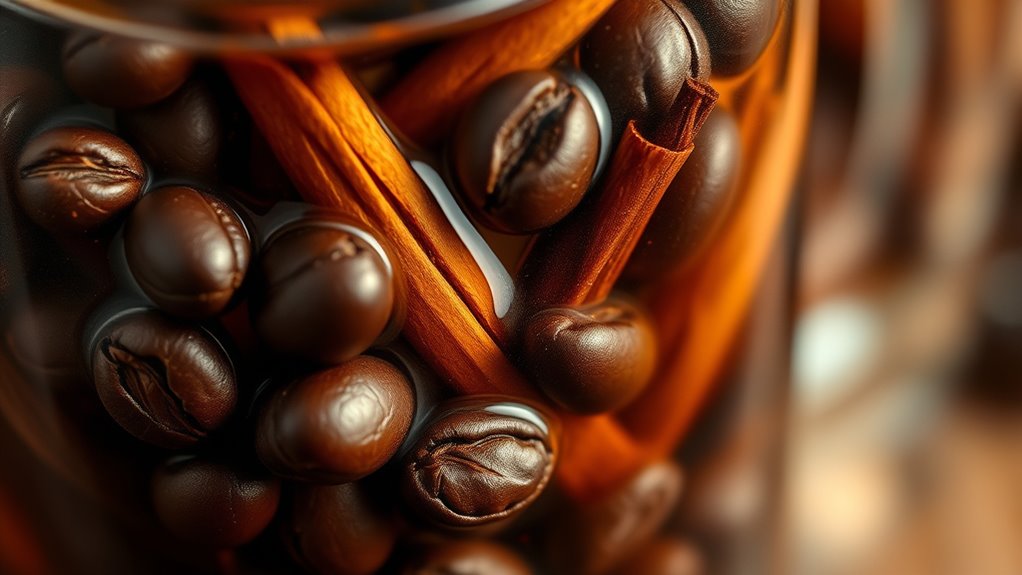To make coffee liqueur from scratch, start by choosing high-quality coffee beans—dark roast for boldness or lighter for subtlety—and brew a strong concentrate. Infuse the beans, vanilla, spices, or citrus into alcohol like vodka, letting it steep for several days to develop rich flavors. Afterward, strain out solids and add sweetener such as simple syrup, honey, or agave, adjusting to your taste. For more tips on mastering infusion and sweetening, keep exploring these techniques.
Key Takeaways
- Select high-quality, dark roast coffee beans and brew a concentrated coffee base for rich flavor.
- Infuse alcohol with ingredients like vanilla, cinnamon, or citrus peels for deep aromatic complexity.
- Strain solids after infusion and let the mixture rest several days to meld flavors fully.
- Gradually add sweeteners such as simple syrup, honey, or agave, tasting to reach desired sweetness.
- Adjust infusion ingredients and resting time to customize and enhance the flavor profile of your homemade coffee liqueur.

Making coffee liqueur from scratch is a rewarding process that allows you to customize flavors and control ingredients. One of the most exciting aspects is flavor infusion, where you can experiment with different coffee beans, spices, herbs, or even citrus peels to craft a unique blend. To start, choose high-quality coffee beans that suit your taste—dark roast for richness or lighter beans for more nuanced flavors. Brew a strong coffee concentrate, as this will form the backbone of your liqueur. Once brewed, you can add flavor infusion elements directly into your alcohol base. For example, toss in vanilla beans, cinnamon sticks, or coffee beans themselves, and let them steep for several days or even a week. This process allows the flavors to meld deeply, creating a complex, aromatic profile that’s tailored precisely to your preferences.
When it comes to sweetening techniques, you have a variety of options to achieve the perfect balance of sweetness. Simple syrup is a classic choice—dissolving sugar in water and adding it gradually until you reach the desired sweetness. Because you control the sweetness level, you can avoid overly sugary liqueurs and keep a more refined flavor. Honey, agave syrup, or maple syrup are excellent alternatives, each lending its own unique flavor note to the liqueur. For a more natural approach, you might opt for fruit-based sweeteners or even lightly caramelized sugar for a richer, deeper sweetness. Remember, the amount of sweetener you add will influence the overall body and mouthfeel of your liqueur, so it’s best to taste as you go.
Blending these techniques—flavor infusion and sweetening—allows you to craft a coffee liqueur that’s perfectly suited to your palate. After infusing your chosen flavors and sweeteners, strain out solids to ensure a smooth finish. Allow the mixture to rest for a few days to let the flavors fully meld. This resting period also helps the alcohol absorb the subtle nuances from your infusion ingredients, resulting in a more harmonious profile. Tasting periodically will help you gauge whether it needs more sweetness or additional flavor infusions. Ultimately, making your own coffee liqueur gives you the freedom to experiment with different ingredients, and fine-tune every aspect until you create a a custom, delicious spirit you’re proud of.
Frequently Asked Questions
Can I Make Coffee Liqueur Without Alcohol?
You can’t make traditional coffee liqueur without alcohol, but you can create alcohol alternatives with non-alcoholic recipes. Use strong brewed coffee, vanilla extract, and a sweetener like honey or syrup to mimic the flavor. You might also add a splash of non-alcoholic vanilla or coffee flavoring for depth. While it won’t be an authentic liqueur, it makes a tasty coffee syrup or mocktail ingredient for those avoiding alcohol.
How Long Does Homemade Coffee Liqueur Last?
You can expect your homemade coffee liqueur to last about 6 months to a year if stored properly. To guarantee freshness, keep it in a sealed bottle away from direct sunlight and temperature fluctuations. Watch for spoilage indicators like cloudiness, off smells, or mold. If any of these appear, it’s best to discard it. Proper storage substantially extends its shelf life and preserves its rich flavor.
What Are the Best Coffee Beans for Infusion?
You should choose medium to dark roast coffee beans for infusion, as they add richer, more robust flavor profiles to your liqueur. These roasts release oils that enhance the depth of the coffee flavor, making your liqueur more aromatic and full-bodied. Light roasts tend to have more delicate, fruity notes that may not infuse as strongly. Select beans based on whether you want bold, smoky, or nuanced infusion flavor profiles.
Can I Customize the Sweetness Level Easily?
Yes, you can easily customize the sweetness level through sweetness adjustment. Start by adding sugar or sweeteners gradually, tasting as you go to achieve your desired flavor balancing. If your liqueur is too sweet, add a splash of unsweetened coffee or alcohol to mellow it out. This hands-on approach lets you tailor the sweetness perfectly to your taste, ensuring a balanced and enjoyable coffee liqueur.
Is It Safe to Add Vanilla or Other Flavorings?
Yes, you can safely add vanilla or other flavorings to your coffee liqueur, but verify they are food-grade for safe flavor extraction and additive safety. Use small amounts initially and taste as you go to prevent overpowering. Vanilla extract, for example,, is a common and safe additive, but avoid using oils or extracts without food-grade approval. Properly stored, your homemade liqueur remains safe and flavorful.
Conclusion
As you savor your homemade coffee liqueur, you might notice the rich aroma lingering like a warm morning sunrise. It’s funny how the simple act of infusing and sweetening transforms everyday ingredients into a comforting, handcrafted delight. Just as you pour a glass, a faint whisper of the coffee beans’ journey from bean to bottle seems to dance in the air, reminding you that sometimes, the best moments are brewed from patience and a touch of serendipity.









